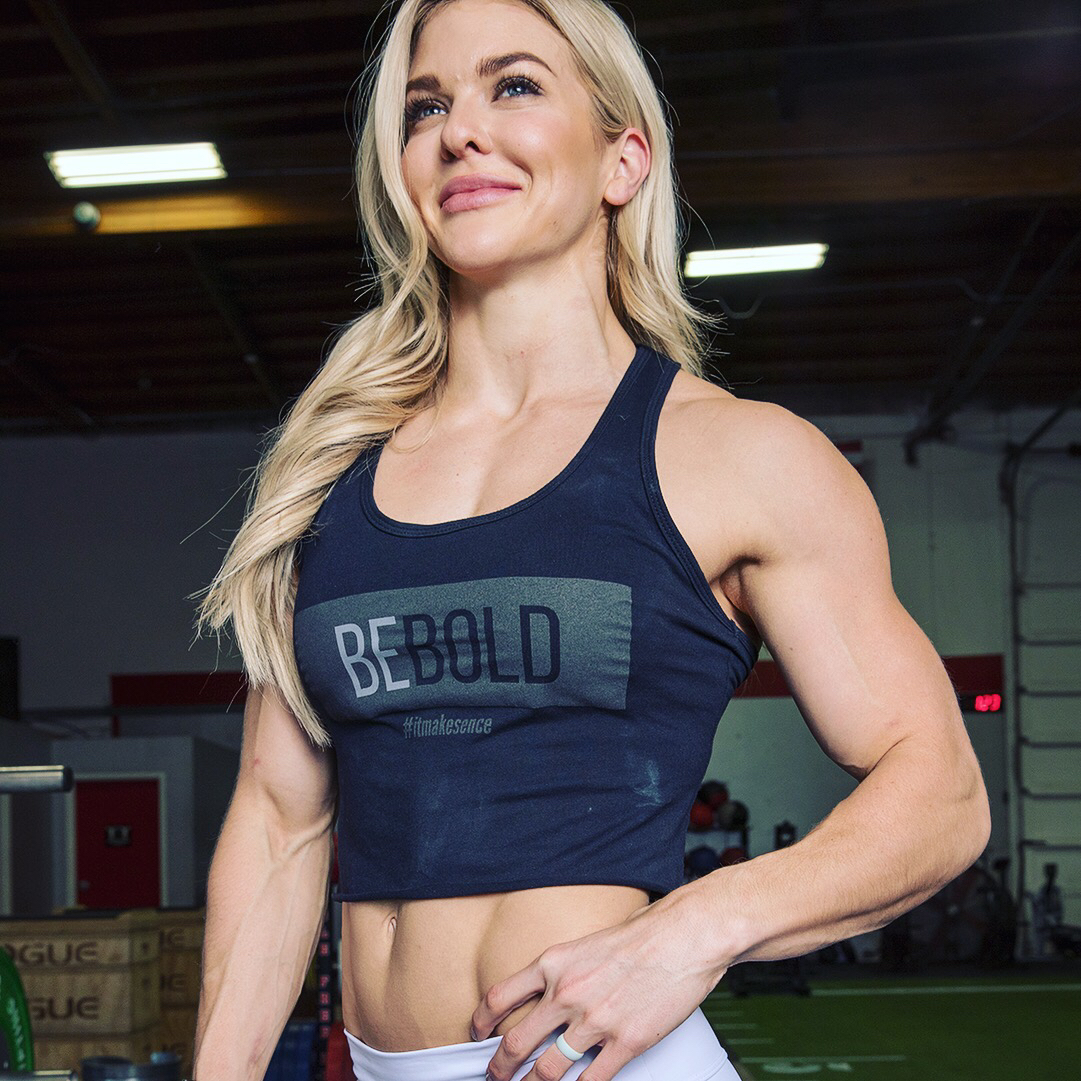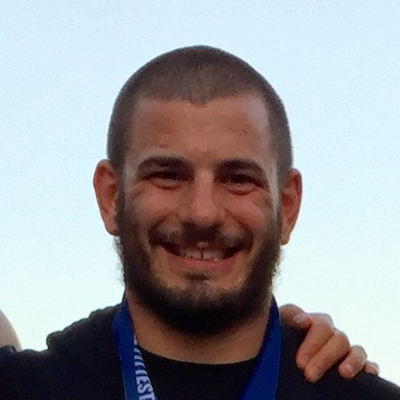It was Saturday evening at the 2015 Reebok CrossFit Games as Lucas Parker prepared to take the platform for Clean and Jerk, and he had to pee.
“Dang, I just went to the bathroom like 30 seconds ago, why do I have to pee again?” he asked himself.
Though it was his fifth Games appearance and he was no weightlifting rookie—his 2013 British Columbia Provincial Championships snatch record of 132 kilos (290 lb.) still stands today—he felt jittery, his heart throbbing in his throat. He reminded himself this was a good thing.
“These are just the things that happen when you’re a caveman running away from a sabertooth tiger,” he said. “The fight or flight system is kicking in, and this is what I want.”
He took a deep breath and shook out his legs, adjusting his privates to get “loose and comfortable” as the countdown boomed throughout the tennis stadium:
Three, two, one, lift.
Parker tore the 325-lb. barbell from the floor, bellowing as he locked it out overhead.

“I’m not sure what exactly that accomplishes,” Parker said of his grunting and groaning. “I’m sure there’s all sorts of theories about firing your deep abdominal muscles … for me it’s more just a barbarian kind of berserk mindset where you’re just looking to rip things up.”
Over the next few days, CrossFit athletes across the world will have the chance to bring out their own inner barbarians in the CrossFit Liftoff, CrossFit’s first online weightlifting competition, powered by Rogue. Though CrossFit athletes are no stranger to the barbell, for many, the CrossFit Liftoff will be an initiation into the world of competitive Olympic weightlifting.
Here, some of CrossFit’s top lifters share their hard-won wisdom.
The Green Room

CrossFit athletes love speed. We’re trained to turn on the moment flesh meets iron, but zero to 100 isn’t always the best course of action, especially when you’re warming up for a weightlifting competition.
“I’m always surprised when I go to a weightlifting meet and it’s full of CrossFitters and everyone’s lifting so quickly and resting so little and doing all these attempts,” Parker said. “They’re warmed up to their opener before the competition’s even started.”
Mat Fraser understands the temptation. A former Olympic hopeful and back-to-back second-place finisher at the 2014 and 2015 Reebok CrossFit Games, Fraser often rushed his warm-ups, even in his Olympic training days.
In a relaxed training session, he’d usually warm up to a max lift in three to five sets at a light weight and two sets at a moderate weight before increasing in 20-lb. increments to 90 percent of his max, followed by 10-lb. jumps to failure. But under the influence of adrenaline, he’d get there in three sets max. Over-zealous and under-warmed, he was more likely to miss his top attempts.
“I would just be too excited, I wanted to hit the heavy weights right away,” Fraser said. “You’re kind of watching the guy on the next platform over, thinking, ‘Well, he’s already at his top weight and I’m still at 60 percent,’ so you start making some bigger jumps, not warming up the way you’re supposed to.”
Brooke Ence, who won both Clean and Jerk and Snatch Speed Ladder in her debut Games performance in July, agreed.
“I know that if I’m warming up to a specific weight and I rush to the weight I’m planning on warming up to … more than likely it’s going to go poorly,” she said. “So I spend a little more time in the moderate weight before I get up to the big numbers.”
Still, sometimes not even the light weights want to go up. When Ence gets stuck on a weight she knows she should be able to nail, she trusts her coaches’ confidence more than her own.
“There’s no easy way of just saying, ‘Oh yeah, I just close my eyes and blink three times and turn around and my stress is gone,’” she said. “No, I usually talk to my coaches. When they tell me what to think or that I’m gonna be OK … I choose to believe them and not believe how I’m feeling.”
Parker sees the silver lining in pre-meet misses.
“Even if I miss my last lift before I step out on the platform, the mentality I would try to hold is, ‘Well, at least I got that miss out of the way now,’” he said. “If I had a good warm-up, great, my body’s ready to exercise and I’m prepared. If the warm-up didn’t go so well, well, I got the yucky stuff out of the way.”
At the Bar

The warm-up isn’t the only danger zone for rushing.
“I think a lot of people think that whatever time we have, whether it’s a minute or 20 seconds, to make a lift is gonna go by fast,” said Lindsey Valenzuela, four-time Games athlete, 2011 U.S. Weightlifting Championships 75-kg second-place finisher and winner of the 2010 American Record Makers Open, 69-kg class.
“And it does, but if you look at a lift in its whole, a snatch should not take more than 10 seconds,” she continued. “The setup and stuff will add some time, but if you’re smart about it and take your time and don’t rush the lift, you’ll make the lift.”
Before Valenzuela approaches the bar, she chalks her hands and quads, tightens her weight belt and stares at the bar. The room fades.
“I don’t focus on anything else but me and the bar,” she said.
When Fraser lifts, he picks a point on the wall in the distance to focus on.
“In the middle of the lift, if you make eye contact with someone, you’re kinda pooched,” he said. “It really throws you off.”
All four of our experts clear their minds. Ence tells herself, “It’s not that heavy,” and then wipes her thoughts of cues and corrections.
“Competition is not a place to make huge jumps and improvements,” she said. “That’s what practice is for. … Because I work on my technique so much and my technique is so good, even in a stressful state, my body will know what to do. It’s like muscle memory.”
Making the Lift

Competition might not be the best place to try fix stubborn tics and flaws, but that doesn’t mean you should abandon thought altogether. As Parker makes his first pull for either the snatch or the clean and jerk, he imagines he’s pushing the floor down and away with his feet, “almost like a bodybuilding leg press,” he said.
Years of deadlifting before practicing the Olympic lifts left Parker too reliant on his hips and hamstrings for strength and power. Setting up for cleans or snatches with nearly straight legs, he would open at the hips, like a door hinge, too soon, leaving no room for vertical drive at the top of the lift.
“If you look at a bodybuilding leg press machine, the one where you lay down on your back and push the machine up and away, your hip and shoulder are both locked in position, and the only thing that’s moving are your legs,” he said. “That’s not the best way to train your body ... but in terms of a visual, if you were to take a snapshot of that and flip it around, you would see that line from the shoulder to the hip is constant and the only thing moving is the platform or the floor underneath them being pushed away in a smooth, linear motion.”
To hit triple extension in her snatch, Valenzuela thinks like Cat Zingano.
“I think about elbowing someone in the face to the right and to the left,” she said. “So your elbows are high and outside rather than you’re dropping your elbows and that bar is coming away from you.”
And even though Ence relies on muscle memory in the moment of competition, she said sometimes pure animal instinct can be too much of a good thing.
“A lot of the time I just wanted to power everything,” she said. “Just up until the past year and a half, the heavier the weight got, the more I didn’t want to use my technique—the more I wanted to muscle it. I had the technique at moderate weight and at lightweight, but when it came to moving real weight around ... I threw it out the window. It was almost like I immediately went to what my body used to do, which was just muscle and power everything.”
In those moments, she issues herself two commands: “Pull yourself down, move your feet,” she said.
If You Miss, Don’t Get Pissed

A more inexperienced Fraser would slam the bar, strike the air and shout after a botched lift, funneling his anger into a second attempt—which, more often than not, was just as sloppy as the first.
“I’d get all riled up after a missed lift and try to hit the next one extra hard,” he said.
His weightlifting coach in 2011, Andrew Tyse, would say, “‘Hey, what are you doing?’ Fraser quoted. ‘What are you wasting all this energy for? You’re making yourself more tired for the next attempt. Sit down, be calm, think about why you fucked up and don’t make the mistake again.’”
“That helped me a lot,” Fraser said. “Me throwing a fit isn’t going to get that bar over my head.”
To help keep his temper down, Fraser now opens with lighter attempts at weightlifting meets or weightlifting events at the Games. Riding on the confidence of an easy opener, he said, helps him nail the heavier lifts.
“It’d be more detrimental if I bombed out,” he said.
In the end, Valenzuela said, the number you post isn’t as important as the experience you have.
“Just focus on what you’re capable of doing in the moment,” she said. “Have a goal, but I think the biggest part is not to put too much pressure on making a certain number. Don’t get fixated on a number, get fixated on the fact that you’re competing for the first time in this, you want to have fun, you want to see where you stack up, and see where you need to improve after.”





